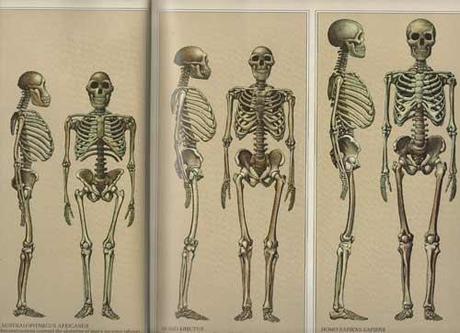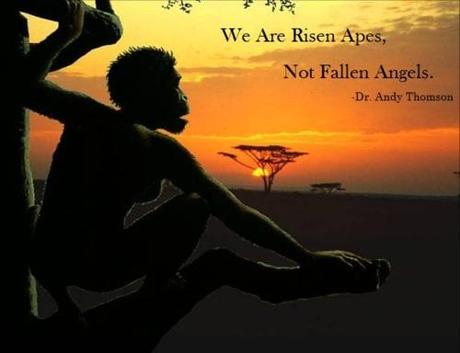And so we arrive at the grand conclusion of Answers in Genesis response (parts 1, 2,3 4 & 5). It follows the standard creationist formula of “finish with a pat on the back of how right we are and some Bible verses showing how God is best” which you’ll recognize if you’ve ever read anything from AiG, the ICR or any of the other similar organisations. Like AiG I’d also like to finish with two final points, although they aren’t quite as self-congratulatory as their’s.
1: what is the significance of a bipedal Lucy?
Lucy appears to be an extinct ape with some anatomical variations not seen in living apes. Anatomical variations, however, do nothing to threaten biblical authority or to support evolution.
….
But even if Lucy and her cousins had a more versatile anatomy than some other apes, tiptoeing through the jungle didn’t make anything ape-like turn into a person. Nothing could. God created Adam and Eve, the first humans, in his image the same day He created apes. We have His own Word on the subject.
Human bipedalism is unique. Whilst other apes are capable of walking upright, none of them do it habitually or as efficiently as us. Even amongst the world of obligate bipeds – such as birds, kangaroos and the such – humans are unique; no other animal walks with our gait. Therefore if evolution were true on would expect to see a group of apes spending more and more time walking bipedally with increasing efficiency until they’re walking like us. Until they are us.
Lucy and her ilk appear to spend some of their time in the trees and some of their time walking bipedally on the ground, which they do with decreased efficiency. As such she’s excellent confirmation of evolutionary anthropology’s prediction, vindicating the science human evolution. And she’s not the only one; in the decades since Lucy was first discovered we’ve found hundreds of fossils all of them telling the same story: a family of apes spent more time being better bipeds until they were indistinguishable from modern humans.
Further, bipedalism isn’t the only trait which tells this story. Humans mature a lot slower than other apes, thus we’d expect this group of apes to show a similar trend of the rate of maturity slowing down. We have bigger brains than other apes, so we’d expect our ancestors to gradually get bigger brains. Humans have much flatter faces than apes, so prognathism should gradually reduce. And lo’, Lucy matured slower than an chimp (but not as a slow as a human), had a bigger brain than a chimp (although not much bigger) and a slightly flatter, more human shaped face. Later species were even more human like in these regards.
These are just some of the predictions made regarding our ancestors and they’re being continually vindicated by new discoveries. Whilst there are many surprises, anomalies and failed predictions enough of them have been confirmed to justify claiming that humans evolved (although the specifics are a little iffy). Further, all of these similarities serve to align Lucy and her ilk with humans. If they had an archaic form of one human like trait that would be suspicious, but when she has several? That’s evolution. As such, when Answers in Genesis claim that Lucy was simply a type of extinct ape and not the “transitional form” evolution would have you believe her to be hopefully you can appreciate how spectacularly they are wrong.

Au. africanus, H. erectus & H. sapiens
2: Answers in Genesis
Previously I’ve avoided examining AiG because they appear to know what they’re talking about. Whilst they’re still wrong, they’re competent enough to make points which would take more time to examine and refute than I was willing to invest in a post. I just don’t have the time to spare to review the literature necessary to offer a cogent reply to what they had to say. Or at least, that’s what I thought until I had to examine their rebuttal. Turns out I had greatly over-estimated their competence.
For starters there’s the inclusion of various snide remarks. Whilst I won’t try and claim I’ve never mocked anyone, I typically try and make it part of a grander, cogent point. AiG has no such illusions, doing little more than poisoning the well. For example, the purpose of my blog is to provide information on evolutionary anthropology since I think there aren’t that many sources out there doing what I do. Their response?
our recent Google search of the phrase “human evolution” produced 230,000,000 results, so there doesn’t seem to be such a paucity of sources
In my original criticism of AiG’s exhibit I wrote about how a biped will “want” their foramen magnum orientated a particular way. I though this was a very obvious metaphor; a linguistic shortcut to simplify the science involved to make it easier and quicker to explain. AiG’s response?
But does evolution address wants and needs? Even among evolutionists, this sort of Lamarckian thinking disappeared a long time ago.
Peel back these childish asides and we arrive at the science. Except it isn’t as half well thought out as I expected it to be. Instead it’s horrifically cherry picked, with so many key examples and facts absent I’m half tempted to say it they’re being intentionally deceitful. For example:
- Whilst they claim the ENCODE project vindicates a creationist prediction (that DNA is all functional), they fail to mention that it has yet to vindicate that prediction even though other AiG writers have admitted it.
- Although some estimation was required to calculate the foramen magnum index of the AL 444-2 skull they don’t mention that you can calculate the foramen magnum index of the AL 822 skull with less ‘guesswork’ and the results closely match those of the AL 444-2 skull.
- Whilst critiquing both the AL 822 skull and AL 444-2 skull for being incomplete and found in pieces, they fail to mention the DK 1-1 skull which is complete and was found intact. DK 1-1 also vindicates the conclusions drawn from the other two skulls, something else they don’t mention.
- They note that some australopithecines have a much lower foramen magnum index that the AL 444-2 skull (19 v 23%) but do not point out that the smaller number is still significantly higher than the foramen magnum index of quadrupedal animals
- The support for their claim that animals which are not habitual bipeds can develop lumbar lordosis comes from two case studies of young gorillas from the 19th century. Not only do they forget to mention that this data comes from young gorillas (who walk bipedally more often than adults) they apparently cannot find any more rigorous examples since specific measurements of the angle of lumbar lordosis were not actually taken from these specimens.
- The single study they cite in support of the claim Lucy was a knuckle walker identifies knuckle walking traits which aren’t actually associated with knuckle walking, fails to realize a bone being examined is broken, has been almost unanimously rejected by the scientific community and doesn’t even conclude that Lucy was a knuckle walker!
- Their claim that Lucy’s hip would’ve prohibited bipedalism is supported by a single 1994 reconstruction of pelvic musculature that couldn’t actually identify where the muscles were really located. Subsequent research was more successful and refuted the conclusions of the 1994 paper.
And with that I sign off, hoping to have convinced you I was right the first time. There’s 5 other posts for you to read which I believe make my case. AiG’s case, conversely, sites upon cherry picked data and snide asides. However, if you still have doubts then please leave a comment below.


